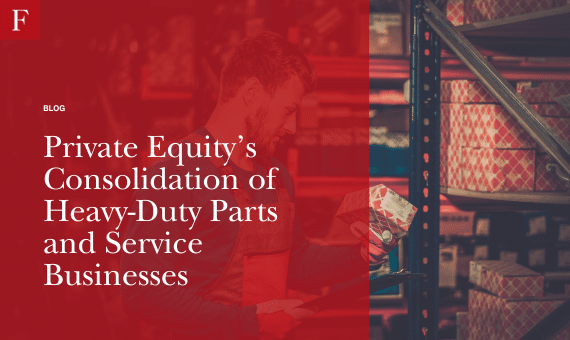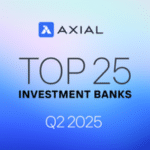
Private Equity and Heavy-Duty Parts and Service Businesses
One of our clients exemplifies this perfectly. They’ve been in business for decades, and the owners recognize it’s time to step away. Demographers and economists suggest that 2023 might have marked the peak year for baby boomer retirements, which is accelerating the transfer of ownership to Generation X and millennials. Beyond retirements, another key driver of industry consolidation is investor interest.
While there are a few public investment opportunities in the heavy-duty parts and service sector, such as Dorman Products (NASDAQ: DORM) and Ryder Systems (NYSE: R), many investors have turned to Private Equity (PE) for investments in the industry. Examples of PE-owned companies include:
- TruckPro (owned by Platinum Equity)
- High Bar Brands (owned by Sentinel Capital Partners)
- S&S Truck Parts (owned by Investcorp)
- FleetPride (owned by American Securities)
You might be wondering, what exactly is PE? PE refers to a form of investment where institutional investors—such as pension funds, mutual funds, and insurance companies—as well as wealthy individuals, provide capital to PE firms. These firms then acquire, grow, and eventually sell companies at a profit to generate returns.
PE firms enhance the value of their investments by providing strategic oversight and operational expertise to management teams that handle the day-to-day operations. The companies that PE firms acquire to grow are referred to as “platforms.” While platforms do grow organically, most investors seek to recoup their investment plus a return within 4-7 years. To expedite this process, platforms often acquire smaller businesses, known as “add-ons” or “bolt-ons.” For instance, TruckPro is Platinum Equity’s platform, and their most recent add-on is Transaxle Parts.
To hone in on PE’s interest in heavy-duty parts distribution and service, it’s important to know that PE firms favor stable businesses in growing markets with predictable cash flows. In other words, they look for businesses that are resilient during economic downturns. While the industry is generally countercyclical to the economy, as parts and services are particularly needed as vehicles age, it doesn’t mean these businesses underperform during a strong economy. Even if the average age of heavy-duty vehicles decreases in a healthy, low-interest-rate market, more miles are driven, which inevitably increases the demand for parts and service. As a result, this sector offers a relatively low-risk opportunity for investors to deploy their capital.
Is consolidation something to fear as a fleet operator or parts/service owner?
From the perspective of the fleet operator, larger, more professional parts and service providers can:
- reduce the costs they pass back to you via the economies of scale they generate like enhanced purchasing power from suppliers;
- offer broader services and act as a ‘one-stop-shop’;
- elevate the customer experience through investments in training, technology, infrastructure, more convenient locations, etc.; and
- improve their financial stability and overall operational health so they are more reliable to the customer.
Some of the cons of consolidation for the fleet operator can be the elimination of relationships, and in rarer circumstances, prices can increase, particularly if a regional monopoly begins to shape up.
For parts distribution and service shop owners, the benefits of consolidation include:
- higher valuations
- acquirers are often willing to pay a premium to increase market share or achieve economies of scale (more detail in my previous column).
- tailwinds for a successful business sale as agreement terms tend to favor sellers over acquirers in an active M&A landscape.
- Keep in mind that many owners like to stay on board for a few years but “take some chips off the table” and get another opportunity to cash out again. If the owner pursues this structure, access to capital for investments, strategic oversight, and operational expertise via PE helps increase the value of whatever ownership is left in the business.
If the owner decides to not sell 100% of the business, some of the cons to consolidation may be more pressure to perform and the loss of autonomy, increased competition through other buyers making their competitors even more competitive, and potentially an impact on customer relationships.
It’s important for owner/operators that are potentially looking to take advantage of consolidation to know that timing, financial health, and preparation matter. Legacy, deal structure, business value, family matters, etc. are all on the table to be negotiated. With all of this said, if you are considering an exit, it’s important for you to talk with a professional M&A advisor so that you can achieve your goals.
M&A Landscape as of Early September 2024
In 2024, we’ve spent a considerable amount of time speaking with some of the bigger PE owned companies mentioned above as well as various regional operators with five or more locations. Each company employs a unique growth strategy tailored to their product and service mix, geographical reach, and other factors. We’re observing that profitable, high-performing assets with strong margins—specifically EBITDA (earnings before interest, taxes, depreciation and amortization) margins of 15% or higher—are commanding valuations in the range of 4.5x to 6x EBITDA on average. However, offers do fall on either side of this range, depending on various factors. Companies with solid margins and revenues exceeding $10 million are particularly attractive acquisition targets for both large and regional operators.
Forward Looking
Private Equity (PE) will continue to be the primary driver of industry consolidation. Regional operators, many of whom remain independent from PE, will persist in acquiring single or multi-location parts and service businesses. It’s important to note that many of these regional players, typically operating in 3-10 locations, may also be positioning themselves for an eventual exit.
With the Federal Reserve having signaled an interest rate cut in September 2024, we anticipate an acceleration in M&A activity. Lower borrowing costs will make debt-financed acquisitions more attractive, further driving the consolidation of the industry. Lastly, PE cash on hand or “dry powder”, has reached an all-time high of ~$2.3T, leaving investors eager to have their cash put to work.
This article was previously published on Fleet Maintenance.
The heavy-duty parts and service industry is comprised of many single location “mom and pop” shops. Many of these businesses are family- or founder-owned, serving fleets within a local radius. In fact, the average establishment date of 2,100 such businesses across the U.S. is 1976, highlighting that baby boomers still own and operate the majority of the industry.













